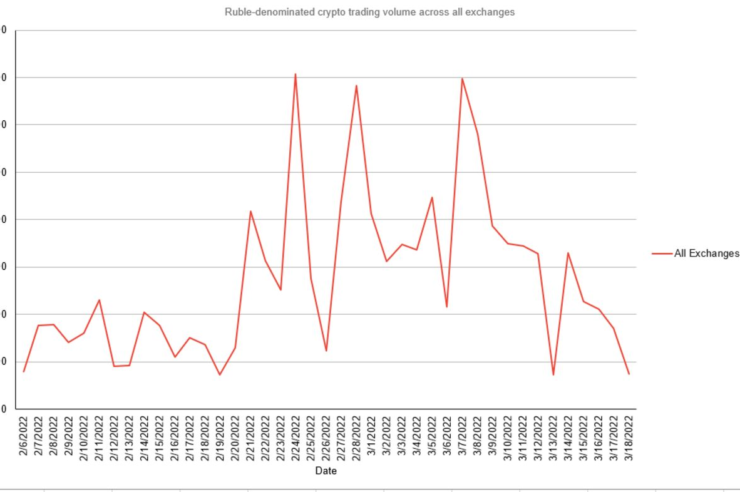The President of the European Central Bank, Christine Lagarde has reiterated warnings that Russian individuals and businesses are using cryptocurrencies to skirt sanctions.
However, as of March 18, daily ruble-denominated crypto trading volume was sitting at just $7.4 million, down over 50% from recent figures and a peak of $70 million on March 7, according to data from Chainalysis.
This amount represents a tiny slither of the total global crypto market volume, with Bitcoin’s total daily volume generally fluctuating between $20 billion and $40 billion.
In a presentation at the Bank for International Settlements Innovation Summit on Tuesday, the crypto skeptic Lagarde said that European financial authorities had seen the “volumes of rubles into stable, into cryptos, at the moment [is at] the highest level that we have seen since maybe 2021.”
Lagarde did not point the finger at the Russian government and outlined that it was primarily Russian individuals and businesses turning to cryptocurrencies. However she said that cryptocurrencies “are certainly being used as a way to try to circumvent the sanctions.”
“So is it [crypto] a threat? Yes. Has it … been a threat in the past? Yes, because when you look at a lot of the dubious transactions that are taking place, a lot of the criminal activities payments that are taking place, very often you find some crypto assets.”
Lagarde’s comments seem to be at odds with data provided by Chainalysis and Kaiko, as well as that of expert opinion. The Blockchain Association’s Jake Chervinsky has said that Russia is unlikely to utilize crypto assets as a method of circumventing Western sanctions.


Data provided by crypto analysis firm Kaiko, showed that ruble to USDT volume is down 86% from its peak of $38 million on March 7 to less than $5 million on March 22. There was a surge in the lead up to the war and spikes afterward, but volumes are now back to levels below that seen throughout most of early February. That’s before sanctions were imposed.
Related: Fighting economic warfare with crypto’s double-edged sword
Conversely cryptocurrency is playing a role in helping Ukrainian refugees escape the country. CNBC told the story of a Ukrainian refugee using the pseudonym “Fadey” who fled the war torn nation with $2000 in Bitcoin on a cold wallet, which made it far easier for him to access his monetary assets once he had reached safety in Poland.
Alex Gladstein, chief strategy officer for the Human Rights Foundation, said that trying to withdraw money from Ukrainian banks in the weeks leading up to the invasion was incredibly difficult and highlighted the difficulties faced by refugees currently attempting to access their funds from countries like Poland.
“How are you going to access your Ukrainian bank account in Poland? Good luck.”
Donations made to Ukraine via crypto assets have skyrocketed over the past 3 months with the overall daily donations being made to Ukraine now sitting at $100.9 million, according to data from Merkel Science.






















Comments (No)